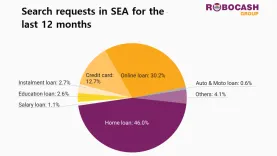In Focus
Fintech funding in SEA freefalls 74% in Q3
Fintech funding in SEA freefalls 74% in Q3
Rising interest rates, macroeconomic factors, and fear of reduced startup valuation caused this downfall.
Why the bank of the future is not really a bank
ANEXT Bank’s Toh Su Mei reveals how they are reimagining banking for small and medium enterprises.
Regulatory caps on neobanks’ operations could stifle growth, expert warns
Despite questions arising from the recent rise of deposit caps in neobanks, incumbent banks are left unfazed.
Tempered adoption of AI tools may spell greater leap for fintech firms
Expert underscores generative AI’s strength in streamlining front-of-office work, but banks on human expertise for in-depth development.
Tech and transformation take center stage at the ABF Summit 2023
Over 180 participants graced the 20+ sessions in the day-long event.
APAC leads globally in terms of cashless transactions – Survey
Evolving risks like geopolitics and cybersecurity are a call for better cash management services.
DBS's Sanjoy Sen explores digital currency, future M&A opportunities
Sen also discussed DBS’ recent integration of Citi Taiwan’s assets in just one weekend.
Hong Kong’s business scholars target top finance employers for work-life balance
Educators at business schools confirm that students’ career priorities have shifted.
Revised rules bolster Korean banks’ competition, but no silver bullet to thriving: analysts
The proposed revisions will pave the way for mergers and bolster competitiveness.
Consolidation in the cards for Australia’s mutual lenders
Mutuals should scale back branch operations and invest in tech.
Vietnam’s 2050 energy transition plan sparks green lending surge
The Power Development Plan 8 helps attract foreign lenders for green projects aligned with Vietnam’s 2050 clean energy goals.
Carbon offset purchases to be a $100b market by 2030
Financial institutions will play a large role in enabling carbon credit financing and carbon offset purchases, says Deloitte.
Hiring freeze felt as HK banks focus on talent development
Many senior roles in banking get cut, but relationship managers, private bankers, and tech roles remain sought after.
Singapore fintech investments record three-year low in H1
Consolidation drove fintech investments in the payments space, KPMG found.
SG incumbent banks unlikely to take hit from neobanks' deposit cap raise: Fitch
Digital banks could face challenges beyond funding.
1 in 5 Thai banks’ restructured loans will go bad: analyst
SMEs will likely struggle to make payments as production costs squeezes profits.
Housing loans, online loans most popular in SEA: study
Analysts said the rise in home loans is likely caused by the region’s geolocation.


















 Advertise
Advertise













Commentary
The future of Asian banking isn’t ‘AI-first’ – it’s ‘fearless-first’
Why APAC banks must rethink their approach to the cost reduction challenge